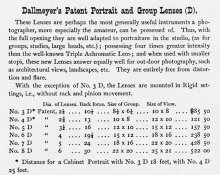df cardwell
Subscriber
The only problem is that the Dallmeyer's Rapid Rectilinear wasn't available until 1866 ( Brit. Patent 2,502/66 ). Steinheil's Aplanat' is identical, and appeared simultaneously (see Rudolph Kingslake, A History of the Photographic Lens. Academic Press, Boston, 1989.)
Howlett was long dead.
It still seems the best guess for Howlett's lens was a Voigtlander. I have no evidence that any other firm but Voigtlander made the Petzval design AT THIS TIME. ( Of course, my resources, as my scholarship, is limited. )
In a few years, everybody made a copy of the lens, and it remained a fixture in portrait studios until the 1920s.
According to Kingslake, the Petzval-Voigtlander breakup was after a 5 year partnership, the quarrel taking place in 1845. The Voigtlander Braunschweig factory was not established until 1849. The Vienna factory was not closed until 1866.
Petzval lost interest in optics after the failure of his second manufacturer in 1862. He continued as Professor of Higher Mathematics at the University of Vienna, and was appointed a member of the Hungarian Academy of Science in 1873.
( Kingslake attributes this information to J.M. Eder, History of Photography, trans. E. Epstean. Dover, New York, 1978)
Don
"This suspense is terrible. I hope it lasts !"
Howlett was long dead.
It still seems the best guess for Howlett's lens was a Voigtlander. I have no evidence that any other firm but Voigtlander made the Petzval design AT THIS TIME. ( Of course, my resources, as my scholarship, is limited. )
In a few years, everybody made a copy of the lens, and it remained a fixture in portrait studios until the 1920s.
According to Kingslake, the Petzval-Voigtlander breakup was after a 5 year partnership, the quarrel taking place in 1845. The Voigtlander Braunschweig factory was not established until 1849. The Vienna factory was not closed until 1866.
Petzval lost interest in optics after the failure of his second manufacturer in 1862. He continued as Professor of Higher Mathematics at the University of Vienna, and was appointed a member of the Hungarian Academy of Science in 1873.
( Kingslake attributes this information to J.M. Eder, History of Photography, trans. E. Epstean. Dover, New York, 1978)
Don
"This suspense is terrible. I hope it lasts !"












 Is it any good? I want an ultra low contrast non coated, simple optic.
Is it any good? I want an ultra low contrast non coated, simple optic. at bottom)
at bottom)